
|
|

Matchbox Superfast MB35-c AEC Merryweather
Fire Engine
|
|
The AEC Merryweather was designed with regular “realistic“ wheels and appears as such on its 1969 `F“ box artwork although in fact it was released in time for Christmas 1969 as part of the original wave of the first new SuperFast castings. Regular wheels prototypes exist painted silver with black baseplates very much like the original 1:1 modelled by Lesney which was in fact largely finished as unpainted aluminium as was the fashion of those times.
This toy was designed to replace the #57 Land Rover fire truck which oddly was also converted to SuperFast wheels for just a few months of 1970. The international appeal of this very beautiful toy (even by Lesney standards!) was in fact so great that the 3rd fire appliance in the 1-75 series in the spring of 1970, the #29 Denver pumper was also deleted from the range without any other fire replacement required.
The body casting was changed twice after pre-pros had been cast, with the original design featuring a 2mm wide step under each side roller locker and a central division of the flat lockers underneath the shield of the label. This was revised and replaced with a flush square cross section bar underneath each side roller locker bar. This was clearly still not strong enough so an additional half millimetre thick sill was added which connected the front wheelarch to the rear wheelarch on each side.
At the same time the hinged locker doors under the label lost their central division in order to make a flatter surface for the shield on the label to stick to. Mixed in with the earliest metallic red production are a small number of pre-pro bodies of both of these first 2 varieties which can also feature baseplates without the “A“ that traditionally indicates the front. A white plastic ladder on the roof completed this fine toy, however pre-production 1969 made black, tan or red ladders exist and some very rare examples have been found on otherwise standard Merryweathers.
The Merryweather was painted with metallic red clearcoat over gold primer for its first few years in the range. It was fitted with a specially designed set of London Fire service labels, blue tinted windows which incorporated the blue roof lamps and a silver-gray plastic baseplate which included the rear panel and side lockers. The Merryweather was recoloured to bright red clearcoat over solid yellow or orange undercoat in 1972.
Standard thin 11x2mm 5 slot SF wheels were fitted, both solid and hollow in all combinations, held on with black or dark red axle clips without any form of sprung suspension. An early metallic red batch was also fitted with the relatively short lived 12.5x2mm thin 5 slot truck wheels. In 1974 it joined the rest of the range switching over to wide wheels, the choice being the same 11x2mm wide 5 slots as fitted to the #45 and #68 Le Mans cars.
In addition to the aforementioned “F“ box, the AEC Merryweather was also packaged in “G“ and “I“ boxes as well as all blisterpacks with copyright dates between 1969 and 1974, with one special issue made by Lesney in 1972 or 1973 printed only with “Flame Proof Wool“ names and logos on both box and bodywork.
Unpainted components for this toy were supplied to Roly Toys of Brazil for final assembly and painting in colours of their choice.
After a three year rest, Lesney revived the Merryweather for the Two-Pack range, and they decided to rivit on the plastic axle securing clips for child safety reasons so wheel swaps can not be carried out on these without easy detection! These TP2 releases can be found with black (with or without #35) gray or cream baseplates and with wide 5 arch wheels or the wide dot-dash type and occasionally even a mixture of both wheel types. The same bright red candy coat over either yellow or orange or pink primer was used, and earliest examples featured the original stickers which were later deleted. The same 3, maybe 4 slightly different baseplate moulds were all still in use mostly likely triplets or quads in one injection moulding tool.A minority of TP2 issues were fitted with #22 Blazebuster yellow “FIRE“ labels.
In 1981 for a special Code Red giftset, Lesney cut the centre out of the cab roof and the rear tank, fitted black seating and a Snorkel moulding, before this revised casting rejoined the 1-75 series in 1982 as the new #63 for a few more years.
|
|
|
|

|
| Above: There must be a big fire somewhere.
|
|
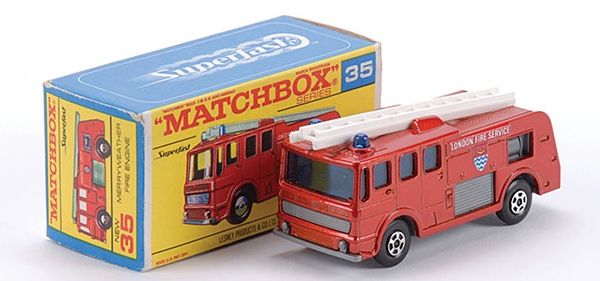
|
| Above: The metallic red version with thin 11x2mm wheels and F type box.
|
|
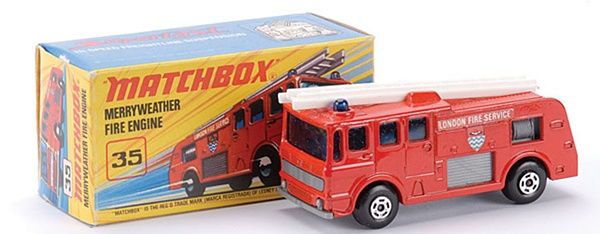
|
| Above: The red gloss Merryweather with 10x4mm 5 slot wheels and I type box.
|
|
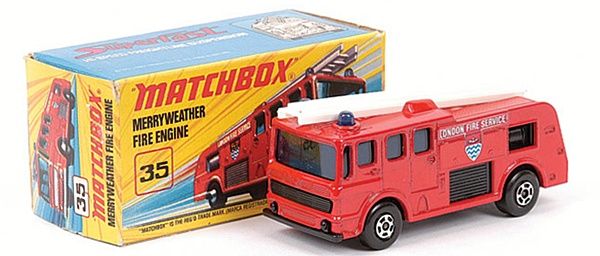
|
| Above: The black baseplate is not easy to find.
|
|
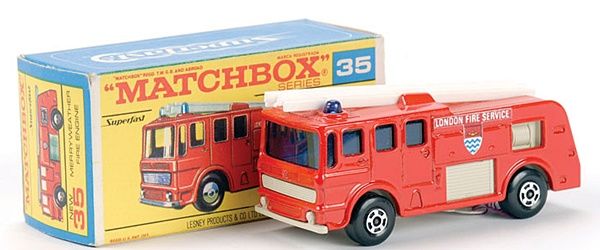
|
| Above: With the hard to find cream plastic baseplate.
|
|
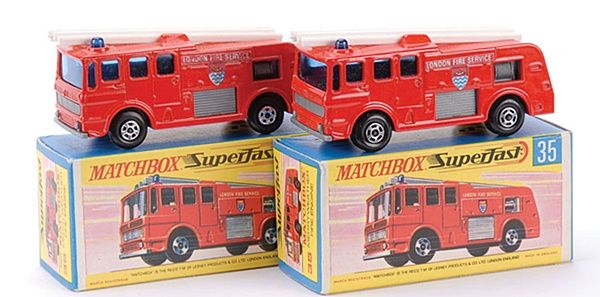
|
| Above: Two Merryweathers and their G type boxes.
|
|
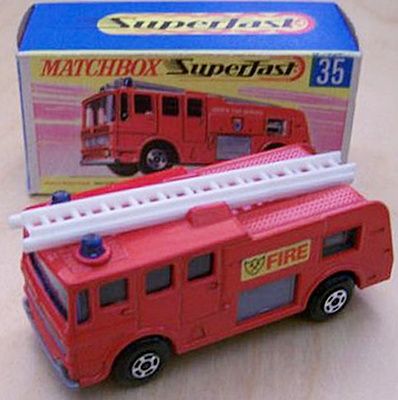
|
| Above: With the "FIRE" label which is normally found on the 22e Blaze Buster.
|
|
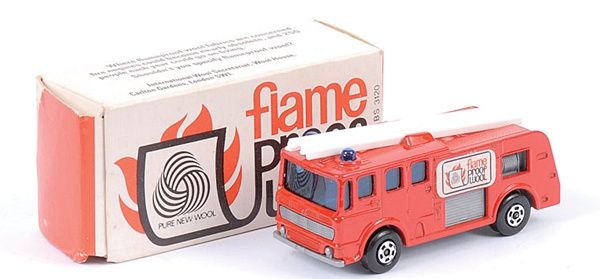
|
| Above: The rare "Flame Proof Wool" promotional issue.
|
|

|
| Above: The Two-Pack TP-2 models had no baseplate number.
|
|
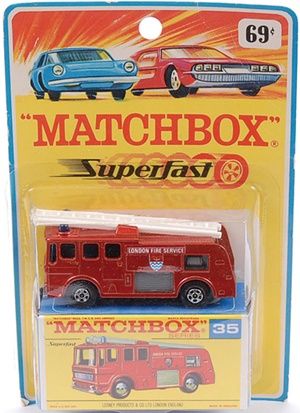 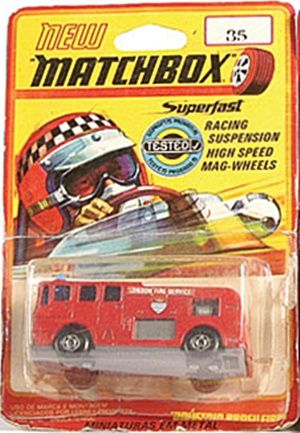
|
| Above: USA and Brazillian blister packs.
|
|
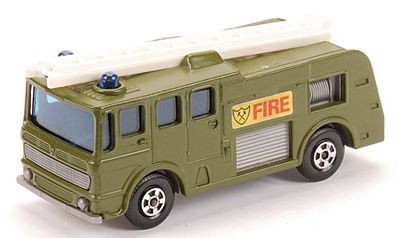 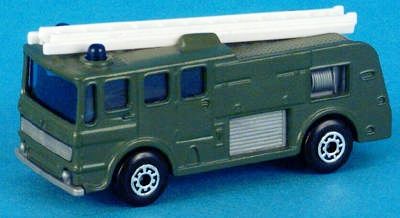
|
| Above: Two colour trial models in olive green and military green.
|
|

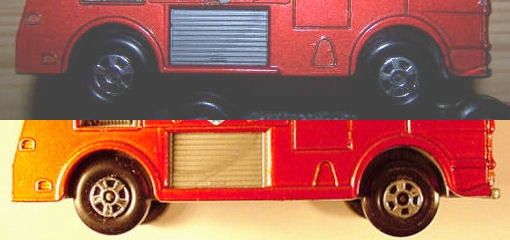
|
Above: Two very unusual Merryweathers, The first is Jason's (nearlymint) which has no raised sills and another photo from Alwin Van Hattem which has very short and thin sills which is directly below the side locker photographed with a standard issue Merryweather at the bottom with the thicker full length sills. These are both obvious pre production castings.
photo's courtesy Jason (nearlymint) and Alwin Van Hattem.
|
|
Note: There are at least 10 different baseplate moldings used for this model,
1/ 'PAT APP' can be on either side of the well while some don't have 'PAT APP'.
2/ The © can be in two different sizes.
3/ the (A) can be with or without brackets ().
4/ The (A) can be on a raised panel, flat or in a recess.
5/ Baseplates will have the number 35 except for TP-2 two packs which had no number
For simplicity sake only the baseplate number and colour have been included in the variation table. |
|
code
number |
colour |
wheels |
baseplate number
+ colour |
labels |
axle fixing |
| code 1 |
metallic red |
11x2mm 5 slot |
35, light grey |
London F.S. |
clip on |
| code 2 |
metallic red |
12x2mm 5 slot |
35, light grey |
London F.S. |
clip on |
| code 3 |
red gloss |
11x2mm 5 slot |
35, light grey |
London F.S. |
clip on |
| code 4 |
red gloss |
10x4mm 5 slot |
35, light grey |
London F.S. |
clip on |
| code 5 |
red gloss |
10x4mm 5 slot |
35, cream |
London F.S. |
riveted |
| code 6 |
red gloss |
10x4mm 5 slot |
35, black |
London F.S. |
riveted |
| code 7 |
red gloss |
10x4mm 5 slot |
35, light grey |
flame proof wool |
riveted |
| code 8 |
red gloss |
10x4mm 5 slot |
35, light grey |
none |
riveted |
| code 9 |
pinkish-red |
10x4mm 5 slot |
35, light grey |
London F.S. |
riveted |
| code 10 |
red gloss |
10x4mm 5 slot |
35, light grey |
Fire (from 22e) |
riveted |
| code 11 |
red gloss |
9.5x4mm dot-dash |
(TP-2), light grey |
London F.S. |
riveted |
| code 12 |
red gloss |
9.5x4mm dot-dash |
(TP-2), dark grey |
London F.S. |
riveted |
| code 13 |
red gloss |
11x4mm 5 arch |
(TP-2), light grey |
London F.S. |
riveted |
| code 14 |
red gloss |
11x4mm 5 arch |
(TP-2), dark grey |
London F.S. |
riveted |
| code 15 |
red gloss |
11x4mm 5 arch |
(TP-2), black |
none |
riveted |
| code 16 |
red gloss |
11x4mm 5 arch |
(TP-2), black |
London F.S. |
riveted |
| code 17 |
red gloss |
11x4mm 5 arch |
(TP-2), grey brown |
London F.S. |
riveted |
|
| Values based on Vectis actual selling prices. |
| metallic red - £30-£40 |
| red gloss, light grey base - £25-£35 |
| red gloss, cream base - £60-£70 |
| red gloss, black base - £50-£60 |
| red gloss, flame proof wool - £350-£450 |
| all others - £25-£35 |
|
|
|
|



